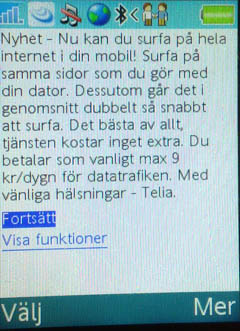I guess many of you have been following discussions on various attempts by network operators to transcode desktop web sites and squeeze them on to a mobile device, without respecting the intentions of content owners. The case I’ll be talking about is the TeliaSonera case, and their “SurfOpen” service. First time around, the launch caused an uprising among the content owners forcing TeliaSonera to go offline with SurfOpen. Now SurfOpen is launched again with a more reasonable approach.
First, a little bit of history: TeliaSoneras first attempt was powered by Novarra. This was a non-transparent proxy which transcoded everything that came in its way. And the most horrible part, placing advertising banners on every transcoded page. (More info and screenshots found here). This is of course a behavior that can’t be supported by content owners and developers. The “SurfClosed” initiative was formed, and all members decided to physically exclude requests from Novarra. TeliaSonera rolled back SurfOpen as a result.

SurfOpen welcome screen, when accessed for the first time
Now, SurfOpen is live again. Is it still a bad thing? No, it’s not all bad. SurfOpen v.2.0 is far less aggressive. In fact TeliaSonera has taken the mobile industry in Sweden very seriously, listened to and cooperated with content owners and developers to find a good solution.
So what has happened? First of all, Novarra was replaced by Byte Mobile. As far as I know, the Byte Mobile transcoder is powered by Opera (same software that transcodes desktop web sites for Opera Mini, or Opera Turbo-like thing). As you can see from the HTTP header below, the transcoding proxy identifies it self in the Via header. Also note the x-operamini-* headers. The proxy is also fully transparent this time. This means that URLs are preserved.
A sample HTTP header (sorry for the php look).
[code]
DOCUMENT_ROOT] => /home/mpulpmo/public_html
[HTTP_ACCEPT] => text/javascript, text/ecmascript, application/x-javascript, application/java-archive, application/java, application/x-java-archive, text/vnd.sun.j2me.app-descriptor, text/x-co-desc, text/vnd.nokia.rs-tgd, text/html, application/vnd.wap.xhtml+xml, application/xhtml+xml, text/css, text/vnd.wap.wml, application/vnd.wap.wmlc, application/vnd.wap.wmlscriptc, application/vnd.oma.drm.message, application/vnd.wap.mms-message, application/vnd.wap.sic, application/vnd.oma.dd+xml, */*, text/vnd.wap.si, text/vnd.wap.wmlscript, image/*;q=0.9, application/javascript, application/vbscript, application/xml;q=0.9, image/png, image/jpeg, image/jpg, image/gif, image/x-xbitmap
[HTTP_ACCEPT_CHARSET] => iso-8859-1, utf-8, utf-16, *;q=0.1
[HTTP_ACCEPT_ENCODING] => deflate, gzip, x-gzip, identity, *;q=0
[HTTP_ACCEPT_LANGUAGE] => no;q=1.0, en;q=0.5, fi;q=0.5, sv;q=0.5, is;q=0.5, da;q=0.5
[HTTP_CACHE_CONTROL] => max-age=259200
[HTTP_CONNECTION] => keep-alive
[HTTP_COOKIE] => PHPSESSID=75f65899476ea46ff8b2b614714be581
[HTTP_COOKIE2] => $Version=1
[HTTP_HOST] => mpulp.mobi
[HTTP_USER_AGENT] => NokiaE65-1/3.0 (1.0633.18.01) SymbianOS/9.1 Series60/3.0 Profile/MIDP-2.0 Configuration/CLDC-1.1
[HTTP_VIA] => 1.1 Bytemobile OSN WebProxy/4.1
[HTTP_X_BMI_CA_UPSDOMAIN] => 1.2.3.50
[HTTP_X_OPERAMINI_PHONE_UA] => NokiaE65-1/3.0 (1.0633.18.01) SymbianOS/9.1 Series60/3.0 Profile/MIDP-2.0 Configuration/CLDC-1.1
[HTTP_X_WAP_PROFILE] => ‘http://nds1.nds.nokia.com/uaprof/NE65-1r100.xml’, ‘1-v4m6VXcj3NCzk1xrFxVd9A==’, ‘2-XnrTOLDzBJdZHN2vSasoNA==’, ‘3-ng5EuV6ttJfSLEU/i1fAbQ==’
[/code]
As mentioned, TeliaSonera has listened to the players in the mobile industry before this re-launch. TeliaSonera invited Mobiletech (where I work), representing the developers and software providers, and Byte Mobile for a workshop on how to re-launch SurfOpen.
So the current state is that SurfOpen behaves as one would expect in terms of mobile optimized sites: User-Agent untouched, no-transform header respected, redirection from desktop web side if is set and of course no ads on top of mobile sites. Desktop sites without reference to its mobile equivalent are still transcoded to fit the mobile. These sites still gets the TeliaSonera advertising banner on top of the page as well. Well, Rome was not built in a day. I choose to think of this as a kick in the behind for the owners of these sites to focus on their mobile presence.

A transcoded web site. Ads and nav bar added
So, well done TeliaSonera! If you, dear reader, are working on a transcoding project for a operator, I urge you to take note of the deployment model of SurfOpen in the Swedish market! You get the best from both worlds. I am happy to put you in contact with the right people in TeliaSonera.






